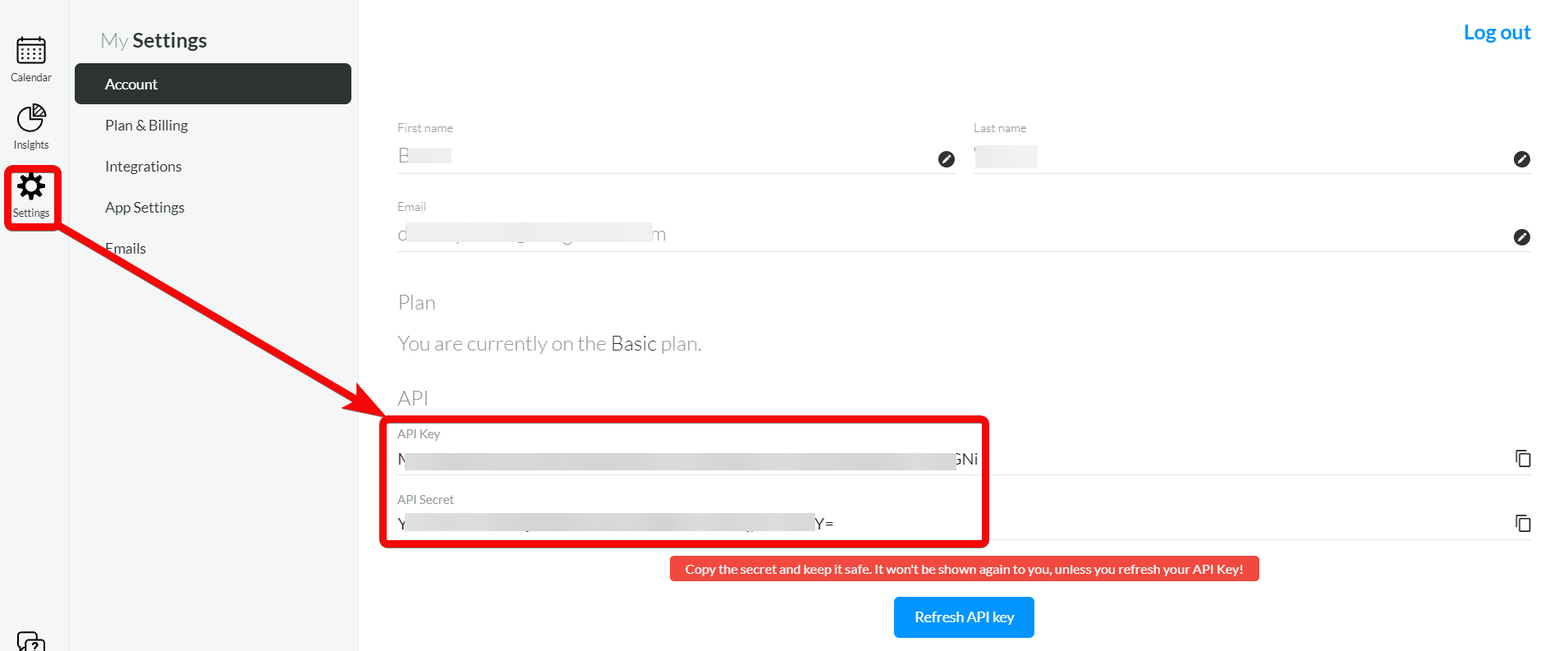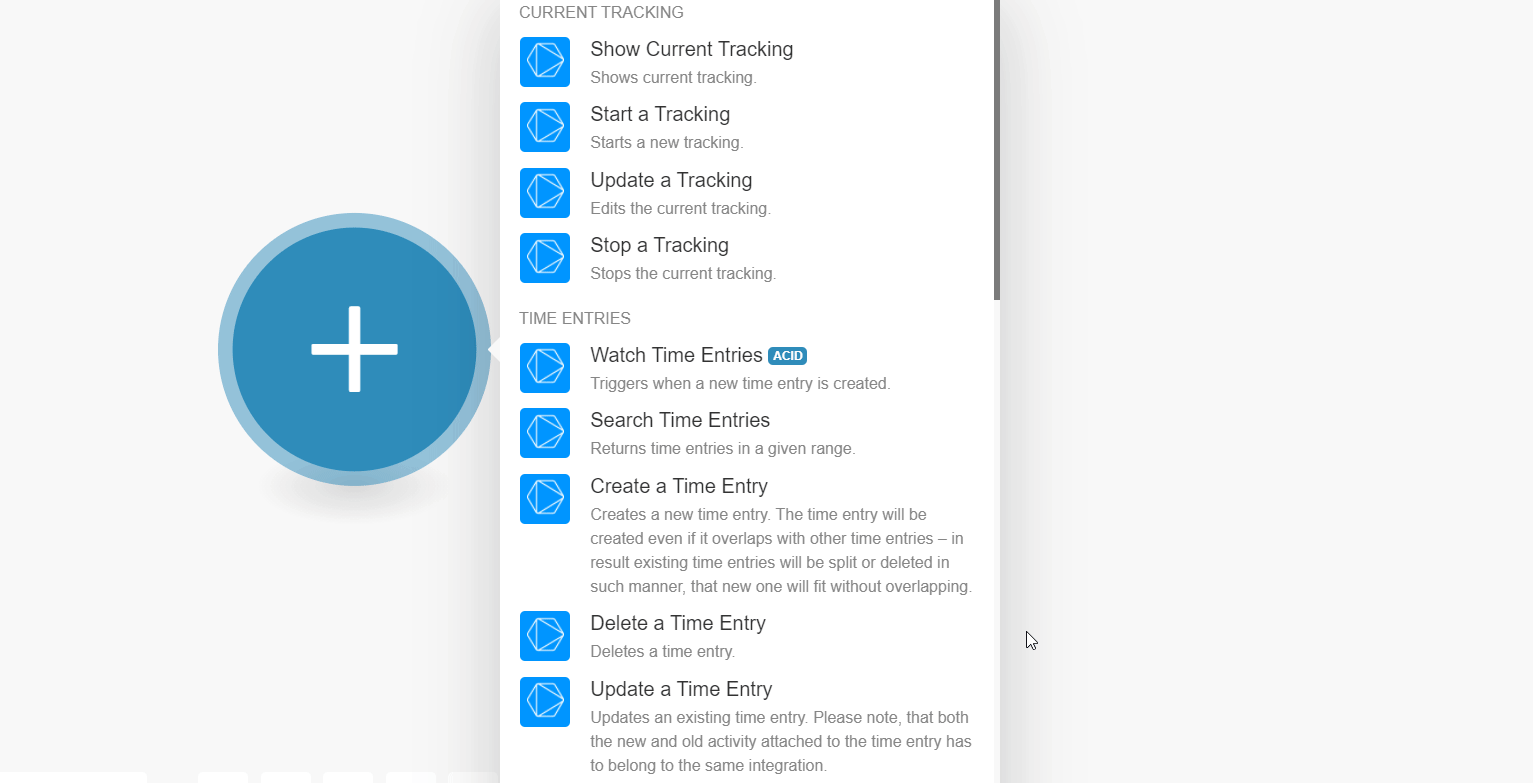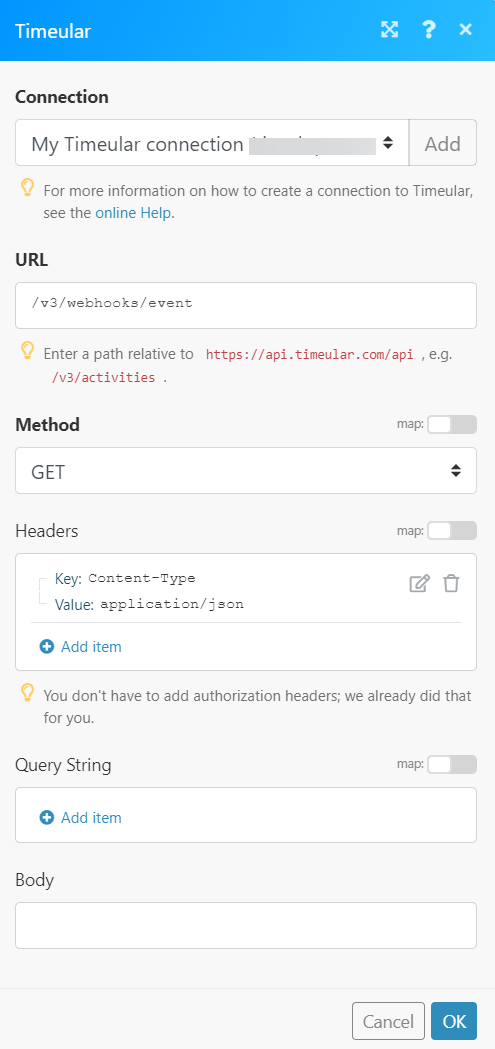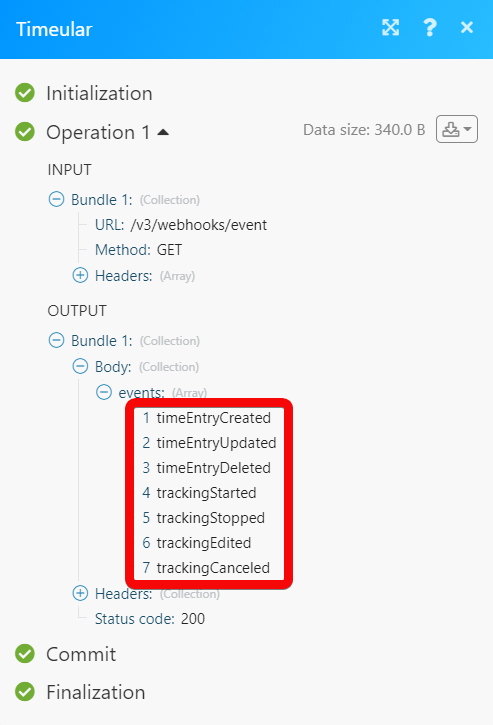| Active with remarks |
|---|
| This application needs additional settings. Please follow the documentation below to create your own connectionUnique, active service acces point to a network. There are different types of connections (API key, Oauth…). More. |
The Timeular modulesThe module is an application or tool within the Boost.space system. The entire system is built on this concept of modularity. (module - Contacts) More allow you to monitor, create, update, show, start, stop, retrieve, list, and delete the current tracking, time entries, activities, tags, and mentions in your Timeular account.
Prerequisites
-
A Timeular account – create an account at timeular.com/pricing/.
Connecting Timeular to Boost.spaceCentralization and synchronization platform, where you can organize and manage your data. More IntegratorPart of the Boost.space system, where you can create your connections and automate your processes. More
To connect your Timeular account to Boost.space Integrator you need to obtain the API Key, and API Secret from your Timeular account and insert it in the Create a connection dialog in the Boost.space Integrator moduleThe module is an application or tool within the Boost.space system. The entire system is built on this concept of modularity. (module - Contacts) More.
1. Log in to your Timeular account.
2. Click Settings and copy the API Key and API Secret values to a safe place.

3. Log in to your Boost.space Integrator account, add a module from the Timeular app into an Boost.space Integrator scenarioA specific connection between applications in which data can be transferred. Two types of scenarios: active/inactive. More.
4. Click Add next to the Connection field.

5. In the Connection name field, enter a name for the connection.
6. In theAPI Key and API Secret fields, enter the API key and secret values copied in step 3 respectively.
7. Click Continue.
The connection has been established.
Shows current tracking.
|
Connection |
Start a Tracking.
|
Connection |
|
|
Started At |
Enter (map) the time at which you want to start the tracking. |
|
Note |
Enter (map) the message text for tracking the time. You can tag or mention usersCan use the system on a limited basis based on the rights assigned by the admin. More at the end of the note text. |
|
Tags |
Select or map the keywords or tags for tracking. |
|
Mentions |
Select or map the users you want to notify or mention in the tracking. |
Edits the current tracking.
|
Connection |
|
|
Activity ID |
Select or map the Activity ID whose tracking you want to update. |
|
Started At |
Enter (map) the time at which you want to start the tracking. |
|
Note |
Enter (map) the message text for tracking the time. You can tag or mention users at the end of the note text. |
|
Tags |
Select or map the keywords or tags for tracking. |
|
Mentions |
Select or map the users you want to notify or mention in the tracking. |
Stops the current tracking.
|
Connection |
|
|
Stopped at |
Enter (map) the time at which the tracking was stopped. |
![[Note]](https://docs.boost.space/wp-content/themes/bsdocs/docs-parser/HTML/css/image/note.png) |
Note |
|---|---|
|
Boost.space Integrator automatically creates a webhookA webhook is a way for an app to send real-time information to a specific URL in response to certain events or triggers. in Timeular once you add an instant triggerEvery scenario has a trigger, an event that starts your scenario. A scenario must have a trigger. There can only be one trigger for each scenario. When you create a new scenario, the first module you choose is your trigger for that scenario. Create a trigger by clicking on the empty module of a newly created scenario or moving the... to your scenario. |
TriggersEvery scenario has a trigger, an event that starts your scenario. A scenario must have a trigger. There can only be one trigger for each scenario. When you create a new scenario, the first module you choose is your trigger for that scenario. Create a trigger by clicking on the empty module of a newly created scenario or moving the... when a new time entry is created.
|
Connection |
|
|
Limit |
Set the maximum number of time entries Boost.space Integrator should return during one execution cycleA cycle is the operation and commit/rollback phases of scenario execution. A scenario may have one or more cycles (one is the default).. |
Returns time entries in a given range.
|
Connection |
|
|
From Date |
Enter (map) a date to search the time entries from the specified date. |
|
To Date |
Enter (map) a date to search the time entries until the specified date. |
|
Limit |
Set the maximum number of time entries Boost.space Integrator should return during one execution cycle. |
Creates a new time entry. The time entry will be created even if it overlaps with the other time entries – as a result existing time entries will be split or deleted in such a manner, that the new one will fit without overlapping.
|
Connection |
|
|
Activity ID |
Select or map the Activity ID for which you want to create a time entry. |
|
Started At |
Enter (map) the start time of the time entry. |
|
Stopped At |
Enter (map) the stop time of the time entry. |
|
Note |
Enter (map) the note text for the time entry. You can tag or mention users at the end of the note text. |
|
Tags |
Select or map the keywords or tags for time entry. |
|
Mentions |
Select or map the users you want to notify or mention about the time entry. |
Delete a time entry.
|
Connection |
|
|
Time Entry ID |
Select or map the Time Entry ID you want to delete. |
Updates an existing time entry.
Both the new and old activity attached to the time entry has to belong to the same integration.
|
Connection |
|
|
Activity ID |
Select or map the Activity ID for which you want to create a time entry. |
|
Started At |
Enter (map) the start time of the time entry. |
|
Stopped At |
Enter (map) the stop time of the time entry. |
|
Note |
Enter (map) the note text for the time entry. You can tag or mention users at the end of the note text. |
|
Tags |
Select or map the keywords or tags for time entry. |
|
Mentions |
Select or map the users you want to notify or mention about the time entry. |
Finds a time entry by its ID.
|
Connection |
|
|
Time Entry ID |
Select or map the Time Entry ID for whose details you want to retrieve. |
Lists all activities.
|
Connection |
|
|
Limit |
Set the maximum number of activities Boost.space Integrator should return during one execution cycle. |
Creates a new activity. It should have a name, a spaceSubunits are created within modules to maintain organization and clarity, even with large amounts of data. More, and a color.
|
Connection |
|
|
Space ID |
Select or map the Space ID in which you want to create the activity. |
|
Name |
Enter (map) the name of the activity. |
|
Color |
Enter (map) the color you want to assign to the activity. For example, |
|
Integration |
Enter (map) the integration you want to apply for the activity.Note: You must have a Pro planCombination of a license (enabled features) and tier (numeric limits) and a subscription period (monthly / yearly). to use third-party integrations, |
Updates the name and color of the activity.
|
Connection |
|
|
Activity ID |
Select or map the Activity ID whose details you want to update. |
|
New Name |
Enter (map) a new name of the activity. |
|
New Color |
Enter (map) the color you want to assign to the activity. For example, |
Archives an activity. It does not affect existing time entries and this activity will still be available in analytics.
|
Connection |
|
|
Activity ID |
Select or map the Activity ID you want to archive. |
Creates a tag within the given space and scope (Timeular is the default).
|
Connection |
|
|
Space ID |
Select or map the Space ID in which you want to create the tag. |
|
Tag |
Enter (map) the tag name you want to create. |
|
Scope |
Enter (map) the scope details in which you want to create. |
|
Key |
Enter (map) a key for the tag. For example, “tagtag”. |
Deletes the given tag.
|
Connection |
|
|
Tag ID |
Select or map the Tag ID you want to delete. |
Creates a new labelA label is a “tag” that can be added to items within a module. It's a flexible tool used to categorize and organize data, making it easier to customize workflows and processes. More for the tag.
|
Connection |
|
|
Tag ID |
Select or map the Tag ID whose details you want to update. |
|
New Label |
Enter (map) a new tag name. The hashtag symbol |
Creates a mention within the given space and scope (Timeular is the default).
|
Connection |
|
|
Space ID |
Select or map the Space ID in which you want to create the mention. |
|
Mention |
Enter (map) the mention name. |
|
Scope |
Enter (map) the scope details in which you want to create the mention. |
|
Key |
Enter (map) a key for the mention. For example, |
Creates a new mention label.
|
Connection |
|
|
Mention ID |
Select or map the Mention ID whose details you want to update. |
|
Label |
Enter (map) a new mention name. The Hashtag symbol |
Deletes the given mention.
|
Connection |
|
|
Mention ID |
Select or map the Mention ID whose details you want to delete. |
Lists all tags.
|
Connection |
|
|
Limit |
Set the maximum number of tags Boost.space Integrator should return during one execution cycle. |
Lists all mentions.
|
Connection |
|
|
Limit |
Set the maximum number of mentions Boost.space Integrator should return during one execution cycle. |
![[Note]](https://docs.boost.space/wp-content/themes/bsdocs/docs-parser/HTML/css/image/note.png) |
Note |
|---|---|
|
Boost.space Integrator automatically creates a webhook in Timeular once you add an instant trigger to your scenario. |
Triggers when an event given in its type parameter occurs.
|
Webhook Name |
Enter (map) a webhook name. |
|
Connection |
|
|
Event |
Select or map the tracking events you want to watch. |
Triggers when an event given in its type parameter occurs.
|
Webhook Name |
Enter (map) a webhook name. |
|
Connection |
|
|
Event |
Select or map the events whose time entry events you want to watch. |
Performs an arbitrary authorized API call.
|
Connection |
|
|
URL |
Enter a path relative to For the list of available endpoints, refer to the Timeular API Documentation. |
|
Method |
Select the HTTP method you want to use: GET to retrieve information for an entry. POST to create a new entry. PUT to update/replace an existing entry. PATCH to make a partial entry update. DELETE to delete an entry. |
|
Headers |
Enter the desired request headers. You don’t have to add authorization headers; we already did that for you. |
|
Query String |
Enter the request query string. |
|
Body |
Enter the body content for your API call. |
The following API call returns all the webhook events from your Timeular account:
URL:/v1/webhooks/event
Method:GET

Matches of the search can be found in the module’s Output under BundleA bundle is a chunk of data and the basic unit for use with modules. A bundle consists of items, similar to how a bag may contain separate, individual items. More > Body > events.In our example, 7 webhook events were returned:

